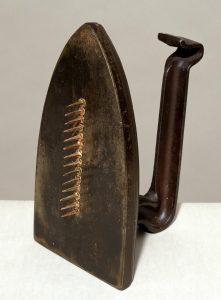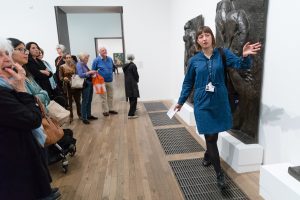Can you believe the break only ended 2 weeks ago? I’m always amazed at how all-absorbing term-time is – I hope it’s all-absorbing for you in a good way!
I’ll begin with a request: we are eager to hear from those of you who are in your final year of your BA studies about how things have gone, and how we can support you as you complete your degree. You’ll have had an invitation to a feedback gathering (if you’re a BA final year student and haven’t had an invitation, please email me: l.topp@bbk.ac.uk). You will soon be asked, by Ipsos-Mori no less, to complete the National Student Survey, which opens this Thursday 25 January and closes on 30 April. You may find me mentioning it quite a bit between now and then…
In a month’s time we’ll be absorbed again in the department’s 50th anniversary events – a 3-day bonanza this time on 22-24 February, kicking off with Tristram Hunt, director of the V&A (and erstwhile member of the Labour shadow cabinet) giving the Anniversary Lecture on ‘Design for a Nation: The Victoria and Albert Museum in the 21st Century’ on the 22nd at 6pm. On the 23rd and 24th we’ll have four fascinating workshops with our own academics joined by experts from the worlds of museums, media and publishing to put our collective finger on the pulse of the discipline and of the museum world we all engage with. Bookings (made via the link above) are very strong – if you can’t get a place for your chosen event, do add your name to the waiting list, since a place may well come up.
And a couple of good things sooner than that:
Birkbeck History of Art PhD Nicola McCartney is now Lecturer in Cultural Studies at Central Saint Martins, and is coming back to Birkbeck to give a talk on ‘Trans and Art’ on Thursday 1 Feb 6.30pm – more details here.
And then on 6 February, 6-7.30 in Keynes we have the next event organised by the History and Theory of Photography Research Centre: Elizabeth Johnson (Associate Research Fellow, Vasari Research Centre for Art and Technology) speaking on
The Touch of Light: Bruce Nauman’s Holograms
Meanwhile our colleague Kasia Murawska-Muthesius will be exploring Europe: She will deliver one of the key-note lectures in the Alterity and the Research Imagination conference https://alterityresearchimagination.wordpress.com/, organised by graduate students of the School of Human Sciences, at Universidade Católica Portuguesa in Lisbon, 25 -26 January 2018. Her talk, entitled ‘Welcome to Slaka, or, the battle of dust-jackets’, (click through to image below) draws from her research on imaging Eastern Europe, and will focus on the use of postcolonial discourse analysis to East European studies. The following week, she will be travelling to Vilnius, invited by the Vilnius National Gallery and the curators of the Oskar Hansen exhibition, to deliver a lecture ‘In the circle of the Open Form: Vilnius, Hoglands & Hansen’s counter-memorial in Auschwitz’, which takes her back to her past research on the encounters between Henry Moore and a visionary Polish architect and urban planner Oskar Hansen.
Our best museums are clearly absorbed in getting you students into their exhibitions – the lastest offer comes from the National Gallery:
The National Gallery would like to extend an invitation to your students for complimentary entry to our latest exhibition, Monochrome: Painting in Black and White, which explores why have artists chosen to paint in black and white over the last 700 years, from van Eyck, Rembrandt, Dürer, and Ingres to Picasso, Malevich, Richter, and Riley.
In order to take up this offer, students will need to show a valid student card to obtain a complimentary ticket from the exhibition ticketing desk in the Sainsbury Wing. The show closes on 18 February.
Another of the big beasts of the London museum scene, Tate, has had the benefit of one of our students, Julija Svetlova, who has recently completed the MA History of Art. Here she is with a guest post on her experience there as a volunteer guide, with a photo of her in action with an absorbed audience (photographer Vickie Flores) and of one of the objects she mentions below.
‘In February of 2016, I applied for a role as Guide at Tate Modern. My application was successful, and I went for an interview for which I had to prepare a five-minute presentation on Man Ray’s surrealist sculpture, Cadeau. I then went through twelve weeks of training, alongside the other prospective guides, and then successfully passed all the tour reviews.
My first experience of addressing the general public was during the Tate Modern extension’s opening week. I did a series of ten-minute talks about the photographs of Bernd and Hilla Becher. In the months that followed I considerably expanded my repertoire and now I run eight 30 and 45 minutes tours. At the Tate, there are no pre-assigned scripts, and the guides are free to choose any artworks they want to for their own research and deliver their own texts. My tours cover a wide variety of art from the 20th and 21st centuries, including photography, painting, sculpture and performance art.
Working as a Guide at Tate has provided me with a unique opportunity to apply the knowledge I accumulated while studying History of Art with Photography at Masters level, from visual analysis and critical thinking, to understanding the collection of one of the most visited art galleries in the world. I see myself as a mediator of meanings between the works of art, curatorial vision and gallery’s visitors. My role is to help Tate’s visitors to understand modern and contemporary art in all its shapes and forms, and I enjoy doing it immensely. The feedback I get from both Tate visitors, and the gallery’s management is very positive and encouraging.
After two years of guiding tours at Tate Modern, as well as occasional tours for private clients, I decided to launch my own guided tour company, which will focus on different art collections around London. I am currently developing a tour, which will focus on art of the Low Countries in the seventeenth-century. A couple of years ago I took Chris Mook’s module Seventeenth-Century Painting in the Netherlands and since then developed a deep passion for the subject.’

Cadeau 1921, editioned replica 1972 Man Ray 1890-1976 Presented by the Tate Collectors Forum 2002 http://www.tate.org.uk/art/work/T07883


